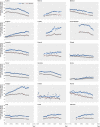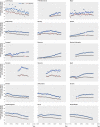Trends in colorectal cancer mortality in Europe: retrospective analysis of the WHO mortality database
- PMID: 26442928
- PMCID: PMC4595561
- DOI: 10.1136/bmj.h4970
Trends in colorectal cancer mortality in Europe: retrospective analysis of the WHO mortality database
Abstract
Objective: To examine changes in colorectal cancer mortality in 34 European countries between 1970 and 2011.
Design: Retrospective trend analysis.
Data source: World Health Organization mortality database.
Population: Deaths from colorectal cancer between 1970 and 2011. Profound changes in screening and treatment efficiency took place after 1988; therefore, particular attention was paid to the evolution of colorectal cancer mortality in the subsequent period.
Main outcomes measures: Time trends in rates of colorectal cancer mortality, using joinpoint regression analysis. Rates were age adjusted using the standard European population.
Results: From 1989 to 2011, colorectal cancer mortality increased by a median of 6.0% for men and decreased by a median of 14.7% for women in the 34 European countries. Reductions in colorectal cancer mortality of more than 25% in men and 30% in women occurred in Austria, Switzerland, Germany, the United Kingdom, Belgium, the Czech Republic, Luxembourg, and Ireland. By contrast, mortality rates fell by less than 17% in the Netherlands and Sweden for both sexes. Over the same period, smaller or no declines occurred in most central European countries. Substantial mortality increases occurred in Croatia, the former Yugoslav republic of Macedonia, and Romania for both sexes and in most eastern European countries for men. In countries with decreasing mortality, reductions were more important for women of all ages and men younger than 65 years. In the 27 European Union member states, colorectal cancer mortality fell by 13.0% in men and 27.0% in women, compared with corresponding reductions of 39.8% and 38.8% in the United States.
Conclusion: Over the past 40 years, there has been considerable disparity in the level of colorectal cancer mortality between European countries, as well as between men and women and age categories. Countries with the largest reductions in colorectal cancer mortality are characterised by better accessibility to screening services, especially endoscopic screening, and specialised care.
© Ait Ouakrim et al 2015.
Conflict of interest statement
Competing interests: All authors have completed the ICMJE uniform disclosure form at
Figures



Comment in
-
[Label for colorectal cancer screening].MMW Fortschr Med. 2015 Dec 14;157(21-22):54. doi: 10.1007/s15006-015-7618-6. MMW Fortschr Med. 2015. PMID: 26960873 German. No abstract available.
References
-
- Ferlay J, Steliarova-Foucher E, Lortet-Tieulent J, et al. Cancer incidence and mortality patterns in Europe: estimates for 40 countries in 2012. Eur J Cancer 2013;49:1374-403. - PubMed
-
- Schreuders EH, Ruco A, Rabeneck L, et al. Colorectal cancer screening: a global overview of existing programmes. Gut 2015;64:1637-49. - PubMed
-
- Jemal A, Bray F, Center MM, Ferlay J, Ward E, Forman D. Global cancer statistics. CA Cancer J Clin 2011;61:69-90. - PubMed
-
- Bosetti C, Malvezzi M, Chatenoud L, Negri E, Levi F, La Vecchia C. Trends in colorectal cancer mortality in Japan, 1970-2000. Int J Cancer 2005;113:339-41. - PubMed
Publication types
MeSH terms
LinkOut - more resources
Full Text Sources
Other Literature Sources
Medical
Miscellaneous
